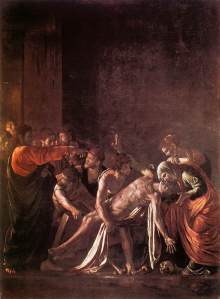 One of the most striking elements of the West Texas landscape is the almost boundless sense of space. Driving north to Lubbock or west to Odessa, it is easy to be overwhelmed by how far one can see, by how little gets in the way of one’s vision. Where I come from, the only place you can see any distance is near the ocean (there are too many trees or hills in the way elsewhere); but in West Texas, you can see for miles and miles wherever you turn. Of course, the boundlessness of the landscape allows West Texans to experience a wide variety of natural phenomena that others have a hard time imagining: spectacularly terrifying thunderstorms that you can see coming long before they arrive, towering dust storms that blot out the sun, and glorious sunrises and sunsets that seem to fill the entire world with uncreated light. The landscape of West Texas is beautiful not because of what it features, but because it is not hemmed in by limits or boundaries.
One of the most striking elements of the West Texas landscape is the almost boundless sense of space. Driving north to Lubbock or west to Odessa, it is easy to be overwhelmed by how far one can see, by how little gets in the way of one’s vision. Where I come from, the only place you can see any distance is near the ocean (there are too many trees or hills in the way elsewhere); but in West Texas, you can see for miles and miles wherever you turn. Of course, the boundlessness of the landscape allows West Texans to experience a wide variety of natural phenomena that others have a hard time imagining: spectacularly terrifying thunderstorms that you can see coming long before they arrive, towering dust storms that blot out the sun, and glorious sunrises and sunsets that seem to fill the entire world with uncreated light. The landscape of West Texas is beautiful not because of what it features, but because it is not hemmed in by limits or boundaries.
There is a level at which the boundlessness of the landscape shapes the way that West Texans look at the world. As a result of the fact that, in the words of one humorist, “West Texas is the world headquarters of nothing,” residents of this area are inclined to believe that you have to make your own way in this world, that no one is going to show you what steps you have to take to move forward. And since the landscape of this region is not hemmed in by limits or boundaries, West Texans are inclined to believe that nearly anything is possible, that there are no limits on what we are capable of doing if we set our minds to it. Both the landscape and ethos of West Texas are shaped by an abiding sense of limitlessness, a belief that the obstacles in front of us are temporary, a feeling that nearly anything is possible.
Over the past several weeks, we have heard stories from John’s gospel that involve Jesus encountering another person in a significant way. At the beginning of Lent, Jesus had his nighttime conversation with Nicodemus. The following week, Jesus met and had a flirtatious conversation with a Samaritan woman. And last week, Jesus healed a blind man, who proceeded to have a protracted dispute with the religious authorities. It occurs to me that the theme running through all of these stories (apart from being very long and making us stand for long periods of time) is that these encounters with Jesus lead people to reevaluate the limited way they look at the world. Nicodemus wonders why Jesus and the Pharisees seem to interpret Scripture in such different ways; Jesus encourages Nicodemus to change the way he understands his relationship with God. The Samaritan woman lives in light of the shameful identity given to her by her community; Jesus tells her that the only identity she should focus on is her status as a child of God. The man born blind is told by the religious authorities that his condition means that he is sinful; by giving this man sight, Jesus affirms that categories like “righteous” and “sinful” are far too simple to characterize the abundant love of God. In these encounters, Jesus moves his hearers from rigidity to openness, from shame to acceptance, from simplicity to complexity, from limits to possibility.
And the encounter described in today’s reading from John’s gospel is also meant to encourage us to reevaluate how we look at the world. You know this story well, because it is easily one of the most dramatic in the New Testament. It’s no wonder that this story is a favorite of those who have chronicled the life of Jesus on film. In several movies, the raising of Lazarus is the climactic end of the second act, the moment that demonstrates how important and powerful this Jesus really is. In many ways, the story of Lazarus is the pivotal moment in John’s gospel. Beginning in chapter twelve, Jesus begins to prepare his disciples for his death. He and his disciples are no longer out in public, but are in houses and upper rooms. And though John tells us that the authorities have tried to stone Jesus a handful of times in the previous chapters, it is after the raising of Lazarus that the authorities actually begin planning to execute Jesus. This leads us to ask: what is so important about the raising of Lazarus? What is it that changes after Jesus calls Lazarus out of the tomb? What is it about this event that makes the authorities decide that Jesus is too dangerous to live?
On one hand, the answers to these questions seem pretty obvious. After all, Jesus raised someone from the dead and demonstrated how powerful he really is. Perhaps a lot of people heard about Jesus’ ability to raise the dead and decided to become his followers. The authorities, in other words, were afraid of Jesus just like they would be afraid of any charismatic leader who bucks the status quo. On the other hand, this answer seems a little simplistic. Roman authorities were pretty good at quashing popular movements that questioned their power. The idea that they would have been particularly worried about a Jewish rabbi, even one who could magically raise the dead, is fairly unlikely. There is a deeper reason for the apprehension of the authorities, and it is tied to the transformation that Jesus effects among the mourners gathered around the tomb of Lazarus.

There are three moments in this story that we should pay attention to. First, even before Jesus arrives at Bethany, there is an interesting exchange between Jesus and his disciples. The disciples remind their teacher that the last time he was in Judea, the people there tried to kill him. The implication of the disciples is clear: “You probably shouldn’t go, because you might end up dead. Worse still, we might wind up dead!” Nevertheless, Jesus ignores the disciples’ fears, ignores the prospect of death, and travels to Bethany to meet his friend. The second moment we need to consider occurs when Jesus arrives. John tells us that Lazarus has been in the tomb for four days; he is, in other words, good and dead. The dead man’s sisters accost Jesus, telling him that if he had been there, their brother wouldn’t have died. In the same way, the crowds say, “This guy opened the eyes of the blind; certainly he could have restored Lazarus back to health, but here we are, mourning his death.” In response to all of this, John tells us that Jesus is greatly disturbed and begins to weep. The crowds assume that he is weeping for his friend, but it is pretty clear that Jesus is weeping for the people around the tomb, the people who are completely paralyzed by the death of Lazarus. Finally, notice that the climax of this story is not when Jesus calls Lazarus out of the tomb; rather, it is when Jesus tells the startled onlookers to “Unbind him, and let him go.”
These three moments in the story of Lazarus point to a meaning that goes beyond its surface. Sure, this is certainly a miraculous account of someone being raised from the dead, but there is far more to this story. Throughout most of John’s account, the people surrounding Jesus are paralyzed by their fear of death: the disciples don’t want to go to Judea because they are afraid they might die, Mary and Martha tell Jesus that he could have prevented Lazarus from dying if he had just been there, and the crowds are lingering around the tomb even four days after Lazarus’ funeral. For the most part, Jesus does not react to the fact that Lazarus has died; instead, he reacts to the fear of death exhibited by the people around him. He goes to Bethany in spite of the disciples’ warning, he tells Martha to trust even in the face of uncertainty, and he weeps because the crowds are imprisoned by their fear of death. And so, in the climactic moment of the story, Jesus tells the crowds around the tomb to unbind Lazarus, to free him from the prison of death, and by doing so he invites the people gathered around him to free themselves from fear, to let themselves be unbound from the specter of death. In his encounter with Lazarus, Jesus moves those around him not from sorrow to happiness, not from despair to hope, not even from death to life, but from fear to fearlessness.
Ultimately, this is why the raising of Lazarus impels the authorities to execute Jesus. As far as they’re concerned, the only unassailable power that tyrants have is the power to take people’s lives. This is why the preferred method of execution in the Roman Empire was crucifixion: by executing dissidents in a public and humiliating way, the Roman occupiers instilled fear among those who might want to rebel. But when Jesus comes along and liberates people from the fear of death, those in power are suddenly impotent; without the fear of death, tyrants have no power to control people. By freeing people from their prisons of fear, Jesus instilled fear among the authorities of this world, demonstrating to them that their power is ultimately fleeting and is coming to an end. By raising Lazarus from the dead and then going willingly to the cross, Jesus demonstrates to us that we have nothing to fear, that when we ground our lives in God, we are not enslaved to limits, but are empowered to embrace possibility.
There are many times in our lives that we are imprisoned by fear. Sometimes, we are afraid to try new things because we’re worried that we might fail. Sometimes, we are afraid to reach out to someone we’ve never met because we’re afraid we might be embarrassed. Sometimes, we’re willing to arm ourselves behind locked doors because of some vague fear of the unknown. But by raising Lazarus from the dead, Jesus reveals to us that our lives are not shaped by success or failure. By raising Lazarus from the dead, Jesus invites us to risk ourselves and be in relationship with those who are different than we are. By raising Lazarus from the dead, Jesus shows us that we have nothing to fear. In these final weeks of Lent, I encourage you to embrace this fearlessness, to turn away from perceived limits, and to acknowledge that anything is possible.